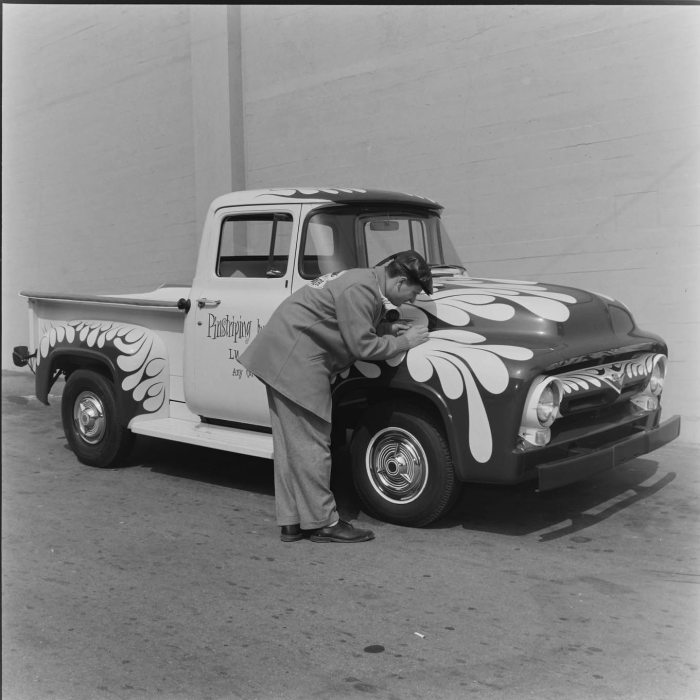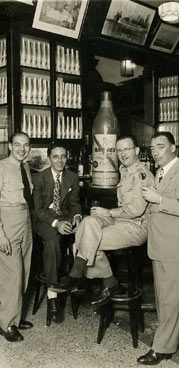Fred Beindorff photographed Ed Roth with his Ford F-100 pickup for Rod & Custom magazine in April 1957. The truck also appeared in the Nov. ’57 issue of Car Craft. Dave Shuten and his crew at Galpin Auto Sports returned the truck to this original state, right down to the Olds Fiesta hubcaps.
Category Archives: disaster
DOES ‘RUSH’ REFERENCE THE BLACK SPIDER THAT FATALLY STRUCK SEBRING BACK IN 1957?
1965 — THE YEAR RICHARD PETTY “THE KING” OF NASCAR TURNED DRAG RACER
In 1964, Mopar unleashed their 426 Hemi-powered fleet at the Daytona 500 and swept Ford clean off the track– taking 1st, 2nd, and 3rd place. Richard Petty (NASCAR 1959 Rookie of the Year, which was amazingly the same year that his father Lee won the Daytona 500) led for an impressive 184 laps, and handily took the win.
That year an outmatched Chevy did not even compete in NASCAR. Ford attempted to debut their new SOHC 427 just days before Daytona– but not only had they failed to list the engine with NASCAR 45 days prior as required, this was not a stock engine at all. Ford was flatly denienied, but even worse than that– Mopar somehow got drug into the high-performance engine debate (many say Ford was muddying the waters for Mopar behind the scenes) that spiraled into the 426 Hemi (reportedly capable of producing 600 HP in NASCAR trim…), which truly was a stock car engine sold to the public, being banned from future NASCAR races.
This easily could have spelled the end of Mopar’s 426 Hemi– arguably the most legendary and iconic American muscle car engine ever. But what Mopar did next was surprising– they decided to turn the tables and boycott NASCAR. This was potentially a major setback for Richard Petty’s racing career, as he was on pace to win the championship that year.
As fate would have it, drag racing was becoming a huge draw– as fans gathered in fevered hordes to see the new wave of super-powered big-block Motor City madness go head-to-head on the drag strips. Plymouth and the Petty crew announced their abrupt move to drag racing– although Petty had no real serious drag racing experience. It would be an exciting, and short-lived venture that would produce a couple of badass Hemi-powered Barracuda dragsters. Unfortunately it was also a period marred by a tragedy that would affect Richard Petty forever.
VICIOUS WHITE KIDS | THE SEX PISTOLS TAKE ON ROCK ‘N ROLL & THE SOUTH
10 Mar 1977, London, England, UK — The punk rock group, The Sex Pistols, are about to be moved by a policeman as they sign a copy of their new recording contract with A & M Records outside Buckingham Palace. The next record to be released is called “God Save the Queen”. The band members (from far left to right) are John Lydon, Steve Jones, Paul Cook and Sid Vicious. — Image by © Bettmann/CORBIS
.
I’m not gonna lie– life has been kicking my ass a little lately. It’s got me wantin’ to spit, sneer, and swear like Sid Vicious. But instead, I’ll humbly take my licks and lumps, and keep on pluggin’ along the best I know how. I actually have a feelin’ this could end up being one helluva year– for TSY and beyond.
I don’t know if I’ve mentioned it here before, but I spend a ton of time in Dallas for business. I’ve been going down for years, and know it pretty well. Calling it my 2nd home is not a stretch by any means– it’s a cool town, and I’m very comfortable there. Lots of great people and good eats.
So, Friday I was having lunch at El Fenix with my buddy Bruce, who’s a few years older than me, and outta nowhere I ask him, “Hey, man– were you in Texas back in ’78 when the Sex Pistols rolled through on tour? You remember them?”
Well, his face lit-up like a Christmas tree as he said, “You mean that Sid Vicious kid? Yeah man, of course I remember it. It was a mess! He was runnin’ his mouth, spittin’, and swingin’ that bass around like a baseball bat on stage– mowin’ people down. They wanted to kill him!”
.
The Sex Pistols’ infamous Dallas, Texas show marquee at the Longhorn Ballroom (once owned by Jack Ruby) back in January of 1978– “Sid was really f*cked up. Really drunk. He played for a while without his guitar plugged in. He played for a while with a fish. I think somebody threw it up there, a bass or something. People seemed pissed at him. He’d spit on the audience; they’d spit on him. That’s what you did. There was this element of, ‘You paid to see us play?'”— The Austin Chronicle
.
THE WHITE TRIPLEX | THREE ENGINES, 1500 HP, AND ONE TRAGIC RESULT
March 9th, 1929, Daytona, FL — Original caption: J.W. White, famous American speed king, standing beside his Triplex machine which he will drive in an attempt to break the world’s automobile speed record. — Image by © Bettmann/CORBIS
.
Jim White was a wealthy Philadelphian who desperately wanted to snatch the land speed record from the hands of British racers Henry Segrave and Malcolm Campbell. Thus, the White Triplex was born. White decided that no single engine would do to challenge the British Napier Lion, so a straight-forward and solid chassis was built, onto which three war-surplus 27-liter Liberty airplane engines were mounted– giving it a total of 36 cylinders, 81 liter displacement, and a staggering 1,500 bhp in all.
The Triplex’s design was a brutish barebones approach– it had no clutch or gearbox, and only a single fixed ratio. Once started by a push start, it had to keep rolling. Driver comforts were minimal to say the least– the forward engine was sheathed in a modest attempt at streamlining, and the two mounted side-by-side in back were totally exposed. The courageous (or crazy) driver was then perched precariously in the middle.
.
Circa 1928-29– White Triplex land speed record car, showing the three engines. Image from the Florida Photographic Collection. Link
.
Ray Keech, an experienced Indianapolis racer, and imposing man with flaming red hair, was paid a handsome sum to drive the White Triplex in the first speed record attempt at Daytona Beach, FL. The first trial runs proved to be dangerous indeed– no one had ever been faced with so much massive power, and in such crude form. Keech suffered burns behind the wheel of both runs– first from a burst radiator hose, then by exhaust flames from the front engine.
The overly simplistic design of the White Triplex posed a particular problem for the officials governing the speed record attempt. The regulations required vehicles to have a “means for reversing”, which the White Triplex definitely didn’t. White’s Mechanics first jury-rigged an electric motor and roller drive onto a tire, but it was unable to rotate against the force of the three large engines, which could not be un-clutched. An even more elaborate “solution” was tried. An entire separate rear axle was fitted, held above ground until dropped by a release lever and then driven by a separate driveshaft. The device was ridiculous, and isn’t believed to have been utilized during the actual speed record attempt itself– but it was enough to successfully satisfy the official’s needs.
On April 22nd, 1928, Keech set a new speed record in the White Triplex of 207.55 mph at Daytona Beach.
*
Circa 1928 — Ray Keech is shown here on the day that he broke the speed record at Daytona Beach, FL. In this image you can clearly see the extra rear axle that was added for record qualification purposes. — Image by © Bettmann/CORBIS
.
“LITTLE BASTARD” | THE SILVER SPYDER PORSCHE/DEAN MYSTERY REVISITED
James Dean on the lot of Competition Motors with his infamous silver Porsche 550 Spyder not long before is tragic death on Sept. 30, 1955 – Image courtesy mptvimages.com. Jimmy had finished shooting George Stevens’ epic “Giant” (notice his hairline was shaved by the studio to play the older, receeding Jett Rink). With the film in the bag, he was now free to race.
.
The day of James Dean’s tragic death behind the wheel of his Porsche Spyder is well documented, as professional photographer Sanford Roth was accompanying Dean for an article on the actor’s passion for racing in Collier’s Magazine. This image shot by Roth in Hollywood on the morning of the accident, shows Dean and Rolf Wütherich preparing for a weekend of racing and camaraderie. That this would be Dean’s final hours, or that Wüetherich was about to experience a life-shattering event, was clearly the furthest thing from either one’s mind. Julien’s Auctions sold an 11×14-inch print of this shot, taken from Roth’s original contact sheet and mounted on foam core, for $1,500. It is confirmed to be among the last “official” images taken of the actor before his fatal crash. via
EXOTICS, RARE BIRDS, AND CONCEPT TURDS | LET’S PLAY NAME THAT CAR
*
Usually I’m the one going on about cars– here’s your chance to show your stuff. Name all 18 autos and — you tha man.
*
1. 1962 Chevrolet Corvair Monza GT
*
2. 1968 Bertone Alfa Romeo Carabo
*
3. 1970 Porsche Tapiro by Guigaro
*
4. 1970 Lancia Bertone Stratos Concept Car
*
DENNIS HOPPER’S “THE LAST MOVIE” | THE FILM THAT BURIED A VISIONARY
Dennis Hopper and wife Daria Halprin at the Jack Tar Hotel, San Francisco.
From The Village Voice–
The Last Movie was actually to be Hopper’s first. Inspiration hit him in Durango, Mexico, during the making of the John Wayne western The Sons of Katie Elder— “I thought, my God, what’s going to happen when the movie leaves and the natives are left living in these Western sets?” Hopper hoped to make The Last Movie in 1966 but the project fell through when music producer Phil Spector withdrew financial support; his opportunity came in the wake of Easy Rider. Universal gave Hopper $850,000 and total autonomy (including final cut), so long as he stayed within budget.
.
Actor and director Dennis Hopper on the set of his film “The last Movie”, 1971. — Image by © Apis/Sygma/Corbis
Given Easy Rider‘s epochal success, The Last Movie was the most eagerly awaited picture of 1971. After winning an award at the Venice Film Festival, Hopper’s opus opened in New York and broke the single-day box office record at the RKO 59th Street theater, site of Easy Rider‘s triumphant engagement. But unlike Hopper’s first film, The Last Movie was attacked and ridiculed by virtually every reviewer in America and was withdrawn by its distributor within two weeks. Although it achieved a negative notoriety unsurpassed until Heaven’s Gate,The Last Movie was not a financial boondoggle. Hopper’s sin wasn’t wasting money—it was something far worse. The Last Movie is an act of visionary aggression that desecrates Hollywood’s universal church.
.
Actor and director Dennis Hopper on the set of his film “The Last Movie”, 1971. — Image by © Apis/Sygma/Corbis
Fashion’s Shifting Paradigm | A Farewell to Lazy Merchants, Irrelevant Offerings & Bloated Markups
Sorry Antonio— this image is too good, I had to borrow it. The irony is incredible– “Live Beyond Your Means” on the window of a store that went under. Says a lot about the retail climate we’re experiencing.
There’s a lot of reactionary “strategy” in motion right now by apparel retailers & wholesalers who are desperately trying to stop the bleeding. Slash prices, cut inventory levels, homogenize the product, reduce the workforce, cut expenses, close stores– but what’s the long term answer? The industry is facing unprecedented times– but this didn’t happen overnight, and we only have ourselves to blame. The industry is finally paying the price for years of over-saturating the retail landscape with too many stores, an excess of irrelevant “me too” brands & products, and in many cases– undeservedly fat markups.
“The consumer is so well-informed today, they don’t want to be told how to buy and they feel conned and manipulated by big flagship stores, and by the disproportionate margins the brands are making,” Inacio Ribeiro said. “However, the consumer will welcome suggestions, and that is the way forward.”
Fashion’s reliance on ever-lower prices failed last fall, as sale signs shouting 60, 70 and 80 percent off attested. Value is making a comeback across the price spectrum. –WWD
In short– we got fat, lazy & greedy, as the consumer became more sophisticated and savvy. Now they are deciding with lethal force who will survive and who will die– and quite honestly, a lot of us deserve to die.
Nasty Move | Knocking-Off Nat.
It’s been announced that Charlie Sheen is launching his own clothing line based on the “style” of his character on Two and a Half Men. Way to strike while the iron is hot! I think most of the world has moved on–aside from a few guys in Clifton, NJ. Besides, that line already exists–Nat Nast (you may have also noticed their signature retro shirts on The Sopranos and Friends). I think it’s a pretty nasty move. Not only does Charlie fail to openly acknowledge the brand largely responsible for the past success of his character’s look on the show, but now he’s going to line his pockets by knocking them off? Classy move.
I really hope I’ve got this story completely wrong, and that Nat Nast is actually involved in the deal– but unfortunately I haven’t heard their name mentioned once.



















